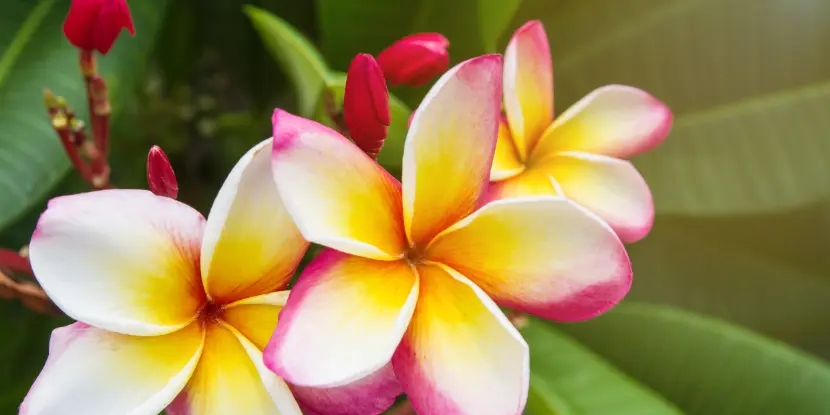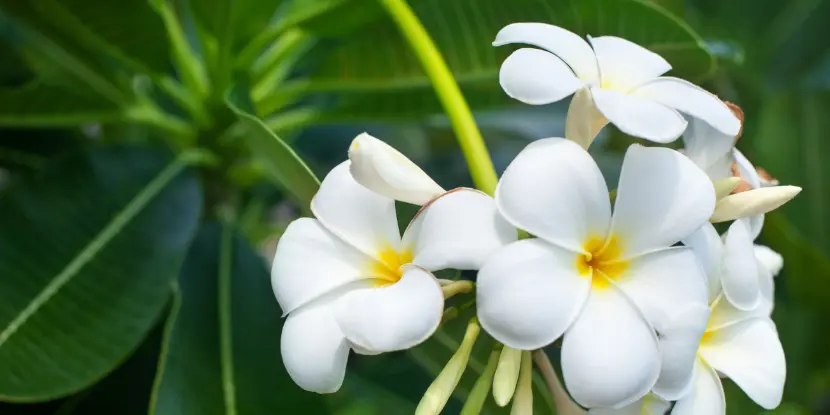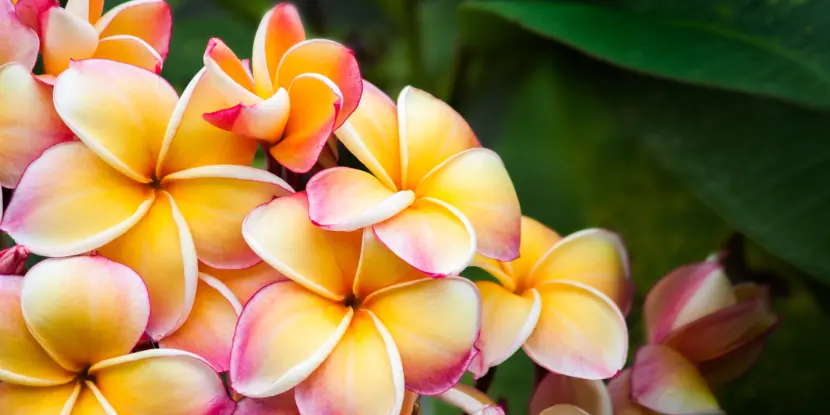Plumeria, also known as frangipani or temple tree, are tropical American shrubs or small trees with sweet, fragrant blooms.
Despite their close association with Hawaii (aloha!), Plumeria plants are native to the Caribbean Basin.
They thrive in Southern California’s relatively mild climate, especially along the coast.
Plumerias are deciduous, stiffly branched, strangely gaunt-looking plants with milky sap and thick, succulent branches. Their leathery, pointed leaves are 8 to 10 inches long. Unless the plant is protected indoors, these leaves usually fall from the plant in late fall or winter.

Pink, white, and yellow Plumeria in bloom.
The Famous Plumeria Bloom
Hawaiian Islanders make leis from showy frangipani flowers, which can be white, white with yellow, pink, pink with yellow, yellow, orange, and red. Flowers range from .75 inches across (dwarf) to 2.5 inches or larger and appear from April to November. Feeding with hibiscus fertilizer in the spring encourages blooming.
Winter Protection
Plumerias are tender to frost. Southern California gardeners often grow them in containers on a porch or patio, where they’ll benefit from as much sun as possible. For any blooming, they need at least half a day of sun.
The plants can be uprooted and stored in a frost-free garage or shed during winter months, then repotted in the spring.
If whole containers are moved indoors for winter, give the plants little water and no fertilizer. Late fall feeding should be avoided; it will produce soft growth that is easily injured by the slightest frost.
Soil Conditions
Plumeria plants thrive in well-draining soil similar to the earth of their natural tropical habitat.
- A sandy or loamy soil mix provides good drainage and aeration.
- Plumeria prefers a slightly acidic to neutral pH level (around 6.0 to 7.0).
- Incorporating organic matter, such as compost or well-rotted manure, can improve soil fertility and moisture retention without compromising drainage.

Pink and yellow Plumeria buds and blossoms.
Potting Soil
Select a potting soil mix designed for cacti or succulents. These mixes typically contain sand, perlite, or pumice to enhance drainage.
You can also create a custom mix by combining equal parts of regular potting soil, sand, and perlite. This composition ensures that the roots remain healthy and free from saturated conditions.
Watering Plumeria
- Before watering, always check the top inch of the soil. If it’s dry, it’s time to water.
- Soak the soil until water flows out of the drainage holes at the bottom of the pot.
- Ensure excess water drains completely to prevent root rot. Avoid letting the plant sit in water.
- Water deeply but less frequently. During the growing season (spring and summer), water every 1–2 weeks, depending on the weather and soil conditions. Reduce watering in the fall and winter months when the plant is dormant.
- Plumerias don’t require additional misting. Regular watering should suffice to maintain adequate moisture levels.

The leathery, large leaves of a Plumeria plant.
Fertilizing Plumeria
- To promote blooming, choose a balanced fertilizer with a higher phosphorus content, such as a 10-30-10 or 5-10-5 ratio.
- Begin fertilizing in early spring, when the plant shows new growth. Continue every 4 to 6 weeks throughout the growing season (spring and summer).
- To avoid burning the roots, mix the fertilizer with water per the manufacturer’s instructions, generally at half the recommended strength.
- Apply the diluted fertilizer around the base of the plant, ensuring it reaches the root zone. Never place fertilizer directly on the leaves.
- Water the plant thoroughly after application to help the nutrients absorb into the soil and reach the roots.
- If growth seems slow or blooms are lacking, consider reevaluating the fertilizer type or adjusting the frequency of application.
Insects & Diseases
Plumerias are susceptible to several insect pests, most notably spider mites. If an infestation should occur, treat it with an insecticidal soap or horticultural oil designed for Plumeria plants.
Certain fungal diseases, including black tip fungus and rust, can affect Plumerias. Fungicide sprays can treat these.
Rust is characterized by bright orange “rusty” spots on the underside of leaves and yellow spotting on the top. The best way to control rust is with a preventative spray. Spray when new leaves emerge in the spring and regularly during the growing season — about every two weeks.

The gnarled branches of a plumeria tree.
Pruning
- Prune in early spring, just before the new growth begins.
- Use sharp, clean pruning shears or scissors to make precise cuts.
- Look for dead, damaged, or crossing branches that need removal.
- Cut just above a leaf node or healthy branch, ensuring not to leave a stub.
- Trim back excessively long branches to shape the plant and encourage bushier growth.
- After pruning, sanitize your tools with rubbing alcohol to prevent the spread of diseases.
Propagation
- Choose a healthy 8–12 inch long branch with at least two nodes.
- Make a sharp, angled cut.
- Allow the cutting to dry for a few days in a shaded area to form a callous over the cut end, which helps prevent rot.
- Prepare a well-draining soil mix, ideally a cactus or succulent mix.
- Insert the calloused end of the cutting into the soil mix, burying it about 2–4 inches deep.
- Lightly water the soil to settle it around the cutting; do not soak.
- Keep the pot in a warm, bright location but out of direct sunlight until roots develop.
- After about 4–6 weeks, check for root development by gently tugging on the cutting. Once firmly anchored, care for it as a mature plant.

Close-up of pink and yellow Plumeria flowers.
FAQs: More about Plumeria Care
Q: How often should I repot my plumeria?
Plumerias benefit from being repotted every 1 to 2 years, especially if the roots have outgrown their current pot. Signs that it’s time to repot include roots growing out of the drainage holes or a noticeable decline in plant health due to root crowding. When repotting, choose a pot only one size larger and use a well-draining soil mix.
Q: Can plumerias be grown indoors?
Yes, as they receive adequate sunlight. A south or west-facing window with at least six hours of direct sunlight per day is ideal. Indoor Plumerias may need more frequent watering, especially during the growing season.
Q: What’s the ideal temperature range for growing plumeria?
Plumerias thrive in warm temperatures, typically between 65°F to 85°F (18°C to 29°C). They can tolerate temperatures slightly above 90°F (32°C) but should be protected from cold drafts and frost, as they’re sensitive to freezing conditions.
Q: How can I encourage my plumeria to bloom?
Ensure your Plumeria receives plenty of sunlight (at least 6 hours a day) and is properly fertilized during the growing season with a phosphorus-rich fertilizer. Also, occasional drought stress can promote blooming, allowing the soil to dry out between watering.
Q: Is it normal for my Plumeria to lose leaves?
Plumerias may shed leaves during the dormant period in fall and winter. This is a natural process as the plant conserves energy. If leaf drop occurs outside of dormancy or is accompanied by other symptoms, it may indicate overwatering or disease.
Q: Can Plumerias be propagated from seeds?
Yes, but it’s less common than propagation from cuttings. If attempting seed propagation, plant seeds in a well-draining mix and keep them in a warm location with high humidity until germination occurs, which can take several weeks to months.
Q: How can I protect my Plumeria from pests?
Regularly inspect your plant for common pests, such as aphids or mealybugs. If you notice any infestations, use insecticidal soap or neem oil to treat the affected areas. Keeping your plant healthy and well-maintained also minimizes pest issues.
Q: Why are my Plumeria’s leaves turning yellow?
Yellowing leaves can result from overwatering, nutrient deficiencies, or inadequate light. To maintain healthy foliage, double-check your watering practices, test soil pH, and provide adequate light exposure.

